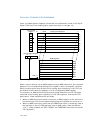
Vol. 3 11-47
MEMORY CACHE CONTROL
4. Enter the no-fill cache mode. (Set the CD flag in control register CR0 to 1 and the
NW flag to 0.)
5. Flush all caches using the WBINVD instructions. Note on a processor that
supports self-snooping, CPUID feature flag bit 27, this step is unnecessary.
6. If the PGE flag is set in control register CR4, flush all TLBs by clearing that flag.
7. If the PGE flag is clear in control register CR4, flush all TLBs by executing a MOV
from control register CR3 to another register and then a MOV from that register
back to CR3.
8. Disable all range registers (by clearing the E flag in register MTRRdefType). If
only variable ranges are being modified, software may clear the valid bits for the
affected register pairs instead.
9. Update the MTRRs.
10. Enable all range registers (by setting the E flag in register MTRRdefType). If only
variable-range registers were modified and their individual valid bits were
cleared, then set the valid bits for the affected ranges instead.
11. Flush all caches and all TLBs a second time. (The TLB flush is required for
Pentium
4, Intel Xeon, and P6 family processors. Executing the WBINVD
instruction is not needed when using Pentium 4, Intel Xeon, and P6 family
processors, but it may be needed in future systems.)
12. Enter the normal cache mode to re-enable caching. (Set the CD and NW flags in
control register CR0 to 0.)
13. Set PGE flag in control register CR4, if cleared in Step 6 (above).
14. Wait for all processors to reach this point.
15. Enable interrupts.
11.11.9 Large Page Size Considerations
The MTRRs provide memory typing for a limited number of regions that have a
4
KByte granularity (the same granularity as 4-KByte pages). The memory type for a
given page is cached in the processor’s TLBs. When using large pages (2 or
4
MBytes), a single page-table entry covers multiple 4-KByte granules, each with a
single memory type. Because the memory type for a large page is cached in the TLB,
the processor can behave in an undefined manner if a large page is mapped to a
region of memory that MTRRs have mapped with multiple memory types.
Undefined behavior can be avoided by insuring that all MTRR memory-type ranges
within a large page are of the same type. If a large page maps to a region of memory
containing different MTRR-defined memory types, the PCD and PWT flags in the
page-table entry should be set for the most conservative memory type for that
range. For example, a large page used for memory mapped I/O and regular memory
is mapped as UC memory. Alternatively, the operating system can map the region
using multiple 4-KByte pages each with its own memory type.


















